
News & Events
Get involved
Nila Davari, Ermelinda Falletta, Claudia L. Bianchi, Viviane Yargeau, Daria C. Boffito
Catalysis Today,2024, 436, 114725
https://doi.org/10.1016/j.cattod.2024.114725
We investigated the photocatalytic activity of TiO2 nanoparticles (TiO2-NPs) and TiO2 nanotubes (TiO2-NTs) supported on a floating polyurethane (PU) foam for removing Bisphenol A (BPA) as a model pollutant. We fabricated TiO2-NPs by the sol-gel method and TiO2-NTs by the ultrasound-assisted hydrothermal method. Subsequently, the photocatalysts were immobilized onto the PU foam through the wet chemical deposition process.
The synthesized photocatalysts were characterized by contact angle, SEM-EDS, TEM, XRD, DRS, and BET analyses. TiO2-NPs and TiO2-NTs were successfully deposited onto the PU foam, creating floating photocatalysts denoted as TiO2-NPs@PU and TiO2-NTs@PU.
Our findings indicated that the nanotubular structure of floating TiO2 photocatalysts enhanced the removal efficiency of BPA relative to the nanoparticles, resulting in the complete removal of the pollutant over 180 min of simulated sunlight irradiation. TiO2-NTs@PU was also stable after five reuse cycles.
Moreover, h+ was the main scavenging reactive species during the photocatalysis of BPA with TiO2-NTs@PU.
Nila Davari, Viviane Yargeau, Daria C. Boffito
We investigated the photocatalytic activity of floating sulfur-doped TiO2 nanotubes (S-TNTs) under simulated sunlight to degrade Bisphenol A (BPA) as a model of resistant organic pollutants. We fabricated the S-TNTs photocatalyst using the ultrasound-assisted hydrothermal method, which was then immobilized onto a floating polyurethane foam (PUF) through the wet chemical deposition process. FTIR analysis confirmed the formation of the Ti-O-S bond in the synthesized S-TNTs photocatalyst.
According to the SEM-EDX analysis, the S-TNTs photocatalyst had a nanotubular structure with an elemental composition consisting of 48.2% Ti, 46.6% O, 0.3% S, 4.8% C, and 0.1% Na. The as-prepared floating S-TNTs photocatalyst completely degraded BPA (10 ppm) after 120 min irradiation of simulated sunlight. Moreover, the floating S-TNTs@PUF photocatalyst had a stable performance over five cycles of use.
Our results suggest that the S-TNTs@PUF photocatalyst provides a promising approach to degrading contaminants in water.
Melissa Greta Galloni, Ermelinda Falletta, Milad Mahdi, Giuseppina Cerrato, Alessia Giordana, Daria Camilla Boffito, Claudia Letizia Bianchi
Advanced Sustainable Systems 2024, 2300565
https://doi.org/10.1002/adsu.202300565
Freshwater represents one of the most precious resources on the planet, so it is fundamental to preserve it. In this work, an innovative sunlight-driven device composed of bismuth oxybromide (BiOBr) grown on a material derived from natural sources, i.e., Lightweight Expanded Clay Aggregates (LECA), is developed to clean surface waters under natural solar light irradiation.
For this purpose, the photodegradation of two non-steroidal anti-inflammatory drugs, ibuprofen, and diclofenac, is investigated under varying operative conditions. Laboratory- and real-scale experiments reveal that the fabricated floating BiOBr/LECA photocatalyst fully degrades diclofenac, whereas limited abatement of ibuprofen is observed.
Based on the identification of specific transformation products (TPs) during the degradation, this behavior seems to be strongly related to the different structures of the two drugs. In fact, the main TP produced during diclofenac degradation derives from dechlorination and ring condensation: this type of photocatalytic degradation pathway is generally favored over the C─C bonds's cleavage, which is a unique possibility for IBU abatement.
Moreover, the potential partial adsorption of these species on the photocatalyst's active sites can cause their deactivation. Finally, reusability tests demonstrate the high stability of the floating composite.
Ermelinda Falletta, Melissa G. Galloni, Nikoletta Mila, Muhammad N. bin Roslan, Noraini Abd Ghani, Giuseppina Cerrato, Alessia Giordana, Mirko Magni, Silvia Spriano, Daria C. Boffito, and Claudia L. Bianchi
ACS Photonics - 2023, 10, 11, 3929–3943
https://doi.org/10.1021/acsphotonics.3c00724
In the present work, the piezoelectric-like behavior of BiOBr nanosheets was utilized to suppress the recombination of photoexcited charges. The piezo-photocatalytic properties of an easily synthesized photocatalyst were tested for the degradation of ibuprofen, a nonsteroidal anti-inflammatory drug.
Under ultrasound and solar light irradiation, the reaction rate for ibuprofen mineralization was found to be higher in the BiOBr nanosheets compared with those from the individual photocatalysis and piezocatalysis approaches, respectively. A percentage of synergy higher than 60% was calculated, resulting in the achievement of complete mineralization in less than 30 min. Based on the results, a possible piezo-photocatalytic mechanism, based on the separation of photoinduced charges and the formation of highly active radicals, has been proposed.
Furthermore, various scavengers were used to identify the active species by trapping holes and radicals generated during the piezo-photocatalytic degradation process.
The main transformation products formed during both photo- and piezo-photodegradation processes were identified by ultraperformance liquid chromatography–mass spectrometry (UPLC/MS), and the ibuprofen degradation pathway was proposed. The very promising results offer an advantageous approach to drug mineralization without the need for costly materials or expensive processes.
Melissa G. Galloni, Ermelinda Falletta, Nila Davari, Daria C. Boffito, Claudia L. Bianchi
Water is one of Earth’s most important molecules: it is essential for life in our world. Climate change is reshaping water access by causing both droughts and floods: there is not enough water, and the amount that is available is usually tainted with some level of pollutants [1].
In this drastic scenario, treating wastewater contaminated by different pollutants is of crucial environmental and commercial importance and urgently requires fast and highly efficient solutions. Heterogeneous photocatalysis has emerged as an interesting strategy for its ability to degrade mixtures of pollutants without the addition of chemical oxidants under mild conditions [2].
However, photocatalytic processes are less effective when used to treat trace concentrations of pollutants in a large volume of contaminated matrices due to the large reactor sizes, the limited light penetration, the high energy cost, and the difficulties in recycling/reusing the photocatalysts. To facilitate the degradation of pollutants traces, different composites have been studied [3].
However, they are nano-sized materials that, although common, raises concerns about nanotoxicity. The ideal photocatalyst should possess activity, selectivity, stability, non-toxicity, cheapness, and easy handling. Achieving all these requirements is a difficult task.
Herein, we present our results related to the development of sustainable photoactive materials obtained by immobilizing innovative adsorptive photocatalysts (i.e., bismuth oxyhalides), on eco-friendly floating supports (e.g., alginate spheres, and Lightweight Expanded Clay Aggregate, LECA).
Their obtained performances in the degradation of different pollutants (e.g., dyes, drugs, polyphenols) after exposure to solar light irradiation will be illustrated. A targeted study of the role of water matrix (ultrapure or simulated drinking water), catalyst dosage, type of floating support and recycling tests, approaching the actual application, will be presented with the aim to provide an insight on potential and limitations of each floating device selected for the real application.
The promising results obtained open the view toward the future real use of these innovative systems, acting as a bridge between environmental remediation and water reuse.
[1] https://www.who.int/news-room/fact-sheets/detail/drinking-water.
[2] Djellabi, R. et al., Curr. Opin. Chem. Eng., 2021, 1, 10069.
[3] Galloni, M.G. et al., Catalysts 2022, 12(8), 923.
Nila Davari, Viviane Yargeau, Daria C. Boffito*
We investigated the photocatalytic activity of floating g-C3N4/rGOunder simulated sunlight to eliminate Methyl Orange as a model of dye contaminants. XRD and FTIR analyses approved the decoration of rGO with g-C3N4 as an n-type photocatalyst. According to the SEM-EDX analysis, g-C3N4/rGO floating photocatalyst had a hollow structure with an elemental composition containing 34.4% carbon, 63.3% nitrogen, and 2.3% oxygen. The as-prepared g-C3N4/rGO floating photocatalyst completely degraded Methyl Orange (10 ppm) during 120 min irradiation by simulated sunlight. Moreover, the floating g-C3N4/rGO exhibited good stability, which kept its photocatalytic activity after five cycles. The results indicated that the floating g-C3N4/rGO could be a promising photocatalyst to purify pollutants.
Nila Davari, Mohamed Gar Alalm, Maryam Mokhtarifar, Claudia L. Bianchi, Ermelinda Falletta, Viviane Yargeau, Daria C. Boffito*
We evaluated the photocatalytic activity of floating g-C3N4 to degrade Methyl Orange as a model of dye pollutants. g-C3N4 was synthesized by the calcination of melamine and then immobilized onto PU foam through incipient wetness impregnation.
Characterization techniques included XRD, DRS, and FESEM-EDS analyses.
g-C3N4@PU photocatalyst could completely eliminate Methyl Orange dye during 300 min irradiation by simulated sunlight. The reusability experiments also indicated that g-C3N4 could be active after five cycles. The scavenging of free radical species revealed that all three active species (i.e., photogenerated holes, hydroxy radicals, and superoxide anions) had significant contributions to the photocatalytic degradation of Methyl Orange.
N. Davari, M. G. Galloni, E. Falletta, C. L. Bianchi, V. Yargeau, D. C. Boffito*
Recent reports show that 2.4 billion people suffer from unsafe drinking water. Photocatalysis is a green solution to provide clean water. The exposure of a photocatalyst to a light irradiation source generates free radicals, which react with organic pollutants present in the water, resulting in the degradation of contaminant. We aim to fabricate a floating photocatalyst involving a 1D Titania nanotube immobilized on Polyurethane foam (TNTs@PU) to remove pollutants from water.
DOWNLOADJune 2023
Among the most well-known pharmaceuticals, non-steroidal anti-inflammatory drugs (NSAIDs) are characterized by a broad scope of properties widely used in human and veterinary medicine.
Because of the growth and aging of the world population, high consumption of NSAIDs has been recorded in the last few years. Consequently, an increase in concentrations of pharmaceuticals in surface waters is on the rise, also due to the low removal efficiency of wastewater treatment plants. Although these drugs have been known for a long time, some information about them is still limited, such as their presence in water bodies, distribution, and eco-toxicological effects.
The traditional wastewater treatment plants have not been effective and efficient enough to remove these pharmaceuticals. To overcome this limitation, new routes are being evaluated for their efficiency in removing these pollutants. Advanced oxidation processes (AOPs) can successfully remove pharmaceuticals from wastewater. Among all the possible exploitable strategies in this field, heterogeneous photocatalysis has emerged as an interesting strategy, operating under mild conditions and degrading many pollutants without adding chemical oxidants. Although TiO2 is still the most used semiconductor due to its chemical and physical stability, good photoactivity, and low cost, researchers are willing to replace it with new smart materials because of its limited activity under solar light and low thermal stability. Moreover, new floating substrates were employed to immobilize photocatalysts to overcome problems related to the use of slurry systems for water purification. Since their closeness to the water surface, these devices can be fully irradiated by the light source, better oxygenated, and easily recovered and reused. Herein, we present our recent results in the NSAIDs degradation under solar light irradiation by innovative visible active photocatalysts (g-C3N4, BiOX) immobilized on natural floating materials (Lightweight Expanded Clay Aggregate (LECA), alginates’ spheres).
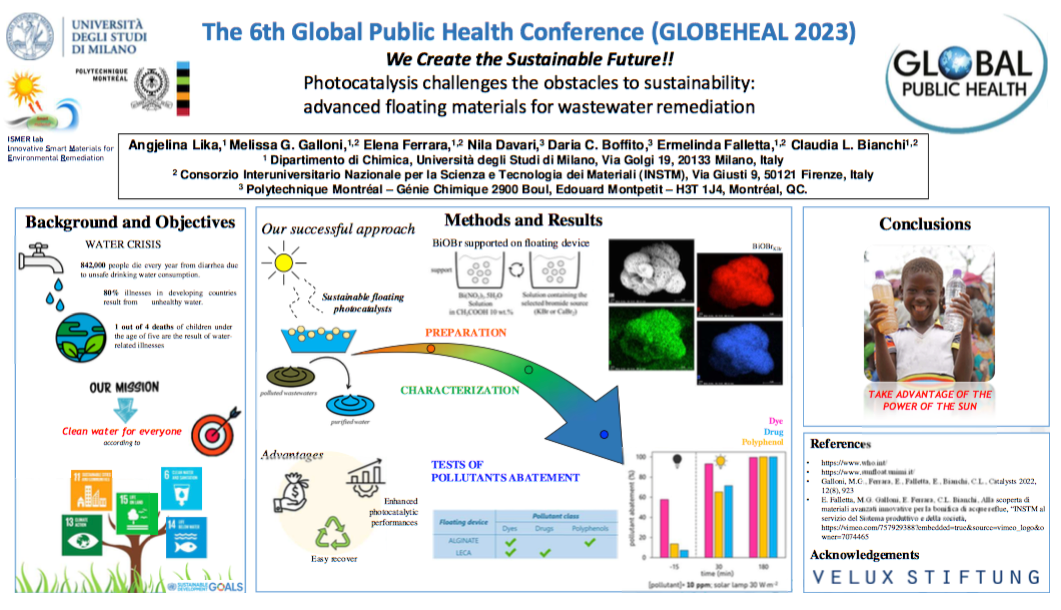
January 2023
The present poster has been selected as the winner of the Poster Award competition of the event The 6th Global Public Health Conference (GLOBEHEAL 2023)
DOWNLOAD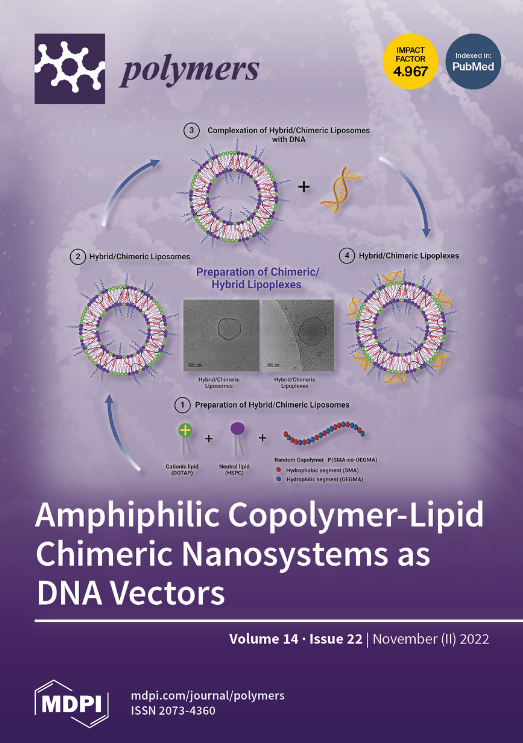
M. G. Galloni, V. Bortolotto, E. Falletta and C. L. Bianchi
Polymers - Volume 14, Issue 22, November 2022
https://doi.org/10.3390/polym14224897
In the last decades, sorbent materials characterized by low selectivity have been developed for the removal of pollutants (in particular dyes) from wastewater. However, following the circular economy perspective, the possibility to selectively adsorb and desorb dyes molecules today represents an unavoidable challenge deserving to be faced.
Herein, we propose a sequential treatment based on the use of PANI-modified loofah (P-LS) and loofah sponge (LS) to selectively adsorb cationic (rhodamine, RHB, and methylene blue, MB) and anionic (methyl orange, MO) dyes mixed in aqueous solution by tuning the adsorption pH (100% MO removal by P-LS and 100% and 70% abatement of MB and RHB, respectively, by LS).
The system maintained high sorption activity for five consecutive cycles.
A simple and effective regeneration procedure for the spent adsorbents permits the recovery of the initial sorption capability of the materials (81% for MO, ca. 85% for both RHB and MB, respectively) and, at the same time, the selective release of most of the adsorbed cationic dyes (50% of the adsorbed MB and 50% of the adsorbed RHB), although the procedure failed regarding the release of the anionic component.
This approach paved the way to overcome the traditional procedure based on an indiscriminate removal/degradation of pollutants, making the industrial wastewater a potential source of useful chemicals.
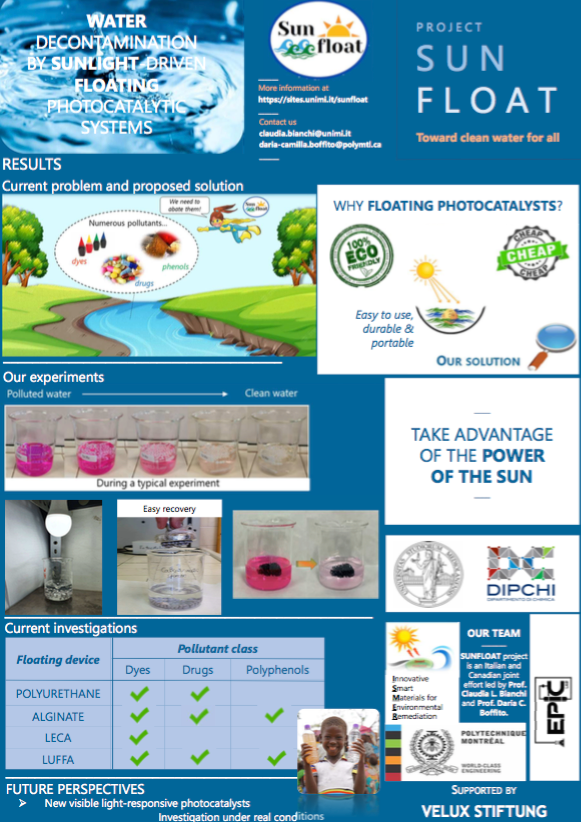
October 2022
The present flyer resumes the status of our research activity done in the first two years of SUNFLOAT project.
DOWNLOAD
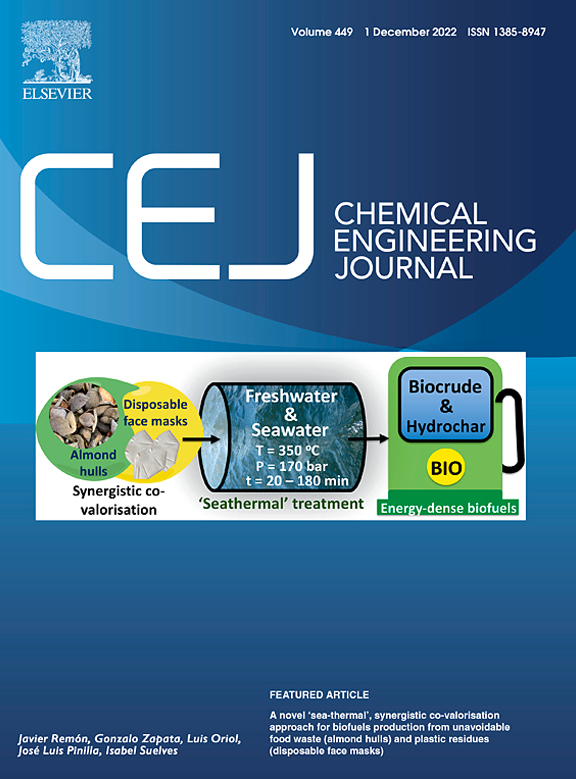
M. Gar Alalm and D. C. Boffito
Chemical Engineering Journal - Volume 450, December 2022
https://doi.org/10.1016/j.cej.2022.138352
Numerous studies have demonstrated the degradation of perfluoroalkyl substances (PFAS) by advanced oxidation or reduction processes. Howbeit, the current literature lacks a comprehensive and comparative overview of the various degradation pathways and mechanisms. This systematic review compiles and analyzes the mechanisms and degradation pathways of PFAS by persulfate activation, photocatalysis, UV/sulfite, electron beam, electrochemical oxidation, plasma, ozonation, and sonochemical oxidation.
We found that the degradation pathways of Perfluorocarboxylic acids (PFCAs) and Perfluoroalkanesulfonic acids (PFSAs) were investigated more than any other PFAS.
This review implies that the defluorination and degradation pathways of PFAS are reliant on the type of dominant reactive oxidant or reductive species. For instance, holes usually oxidize PFAS to unstable perfluoroalkyl radicals accompanied by losing head groups, whereas hydroxyl and superoxide radicals cleave C–C and C-F bonds.
On the other hand, hydrated electrons directly eliminate the head group followed by releasing CF2 units.
Furthermore, the imposed crystal facets and functional groups of the introduced catalytic surfaces in the case of heterogeneous catalysis (e.g., photocatalysts) affected the degradation pathways and defluorination rates by anchoring PFAS molecules from the head groups (e.g., carboxylate and sulfonate group).
This study lays the groundwork for future research to analyze and elucidate the transformation products and pathways of PFAS in various treatment systems.
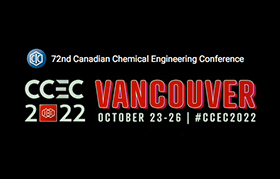
N. Davari, M. Mokhtarifar, C. L. Bianchi, E. Falletta, and D. C. Boffito
Canadian Chemical Engineering Conference - October 2022
As a result of global population growth and industrial development, water pollution is one of the major current environmental issues. Scientific and industrial communities have investigated efficient and economical technologies to address water pollution problems.
Photocatalysis is a promising method to mineralize organic compounds using photoactive materials under light irradiation. Besides, the fabrication of water-floating photocatalysts has received much attention thanks to the high efficiency and technological advantages.
In this research we synthesized a micro-sized TiO2-2%Ag photocatalyst supported on a floating Polyurethane foam using ultrasound and spray dryer to degrade Methyl Orange under simulated sunlight. We characterized the photocatalyst with XRD, XRF, FESEM-EDS, and TEM analyses.
XRD determined the phase of anatase and rutile in TiO2-2%Ag photocatalyst, and the lattice parameters of TiO2-2%Ag were changed by adding Ag, which may be related to the doping of Ag in the TiO2 lattice. Based on XRF results, TiO2-2%Ag photocatalyst had 70.87±1% of Ti and 1.72±0.11% of Ag, and FESEM and TEM confirmed the presence of Ag nanoparticles.
Moreover, EDS elemental mapping demonstrated the homogeneous distribution of Ag in the structure of the TiO2-2%Ag, with the particle size of 105 nm for the Ag-doped TiO2 photocatalyst. We completely degraded 10 mg/L of Methyl Orange at 300 min with TiO2-2%Ag@PU photocatalyst, and the floating photocatalyst was still stable for five reuse cycles. Moreover, Ag in TiO2-2%Ag photocatalyst increased the degradation efficiency of Methyl Orange by 10% and applying ultrasound in the synthesis of TiO2-2%Ag@PU photocatalyst resulted in a 15% rise in the degradation efficiency.
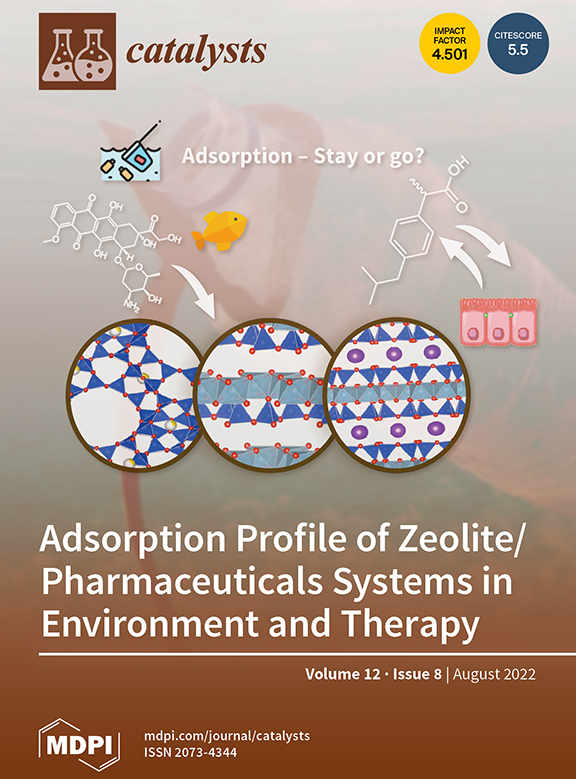
M. G. Galloni, E. Ferrara, E. Falletta and C. L. Bianchi
Catalysts MDPI - Volume 12, August 2022
https://doi.org/10.3390/catal12080923
Olive oil production in Mediterranean countries represents a crucial market, especially for Spain, Italy, and Greece.
However, although this sector plays a significant role in the European economy, it also leads to dramatic environmental consequences. Waste generated from olive oil production processes can be divided into solid waste and olive mill wastewaters (OMWW). These latter are characterized by high levels of organic compounds (i.e., polyphenols) that have been efficiently removed because of their hazardous environmental effects.
Over the years, in this regard, several strategies have been primarily investigated, but all of them are characterized by advantages and weaknesses, which need to be overcome.
Moreover, in recent years, each country has developed national legislation to regulate this type of waste, in line with the EU legislation. In this scenario, the present review provides an insight into the different methods used for treating olive mill wastewaters paying particular attention to the recent advances related to the development of more efficient photocatalytic approaches.
In this regard, the most advanced photocatalysts should also be easily recoverable and considered valid alternatives to the currently used conventional systems. In this context, the optimization of innovative systems is today’s object of hard work by the research community due to the profound potential they can offer in real applications. This review provides an overview of OMWW treatment methods, highlighting advantages and disadvantages and discussing the still unresolved critical issues.
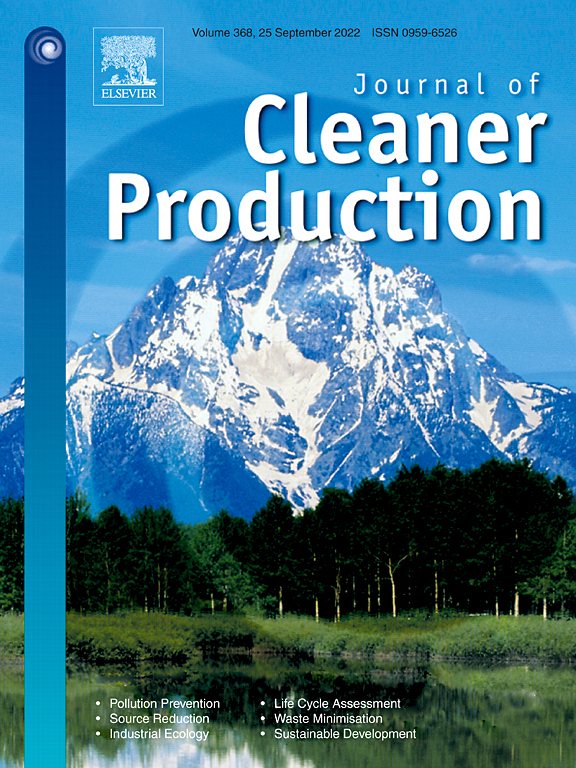
E. Falletta, M. Longhi, A. Di Michele, D. C. Boffito, C. L. Bianchi
Journal of Cleaner Production - Volume 371, August 2022
https://doi.org/10.1016/j.jclepro.2022.133641
Graphitic carbon nitride, both as powder and alginate floating beads, was synthesized by an easy and cheap approach using two different precursors (melamine and urea) and properly characterized by several techniques.
The effect of the type of precursor on the photoactive properties of the final materials was investigated. Their activity towards the photodegradation of different pollutants (dyes, drugs, and herbicides) both in ultrapure water and simulated drinking water under solar light irradiation was investigated, reaching extraordinarily high photodegradation results (99% for diclofenac and rhodamine B and 90% for isoproturon) compared to the literature.
The floating photocatalysts showed good stability during recycling maintaining high performances after 5-time usage without post-treatment. Finally, liquid chromatography equipped with mass spectrometry (UPLC/MS) was used to identify the main by-products formed during the photodegradation tests, and a plausible transformation pathway has been proposed.
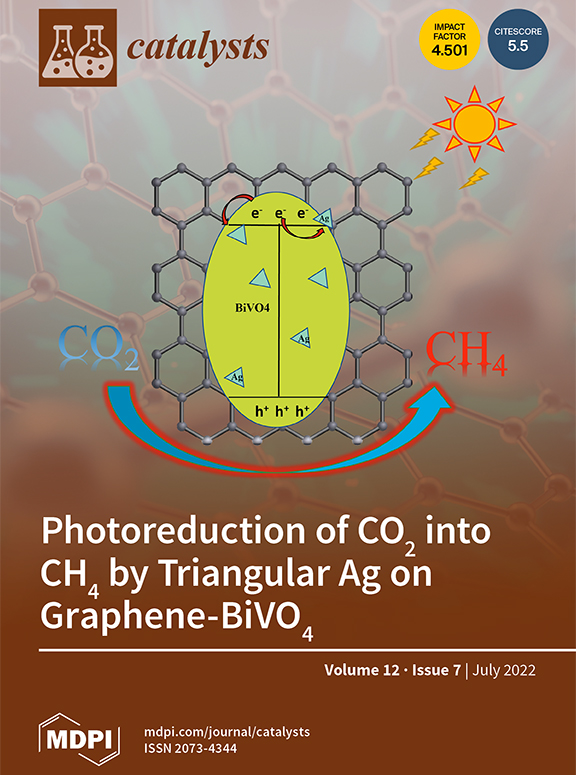
M. G. Galloni, G. Cerrato, A. Giordana, E. Falletta and C. L. Bianchi
Catalysts MDPI - Volume 12, July 2022
https://doi.org/10.3390/catal12080804
Currently, photocatalytic reactions under solar illumination have attracted worldwide attention due to the tremendous set of associated environmental problems. Taking sunlight into account, it is indispensable to develop highly effective photocatalysts. Strontium titanate, SrTiO3 (STO), is a cubic perovskite-type semiconductor, an inexpensive material with high thermal stability and corrosion resistance that exhibits a similar energy bandgap to TiO2 and can represent an interesting alternative in photocatalytic applications. Particle size can significantly affect both photocatalytic and photoelectrochemical properties of a photocatalyst, thus altering the photooxidation of organic pollutants in air or water.
In this context, this research aims at investigating the photocatalytic features of nano- and micro-sized commercial STO powders towards the photodegradation of diclofenac (DFC), a non-steroidal, anti-inflammatory drug, widely used as analgesic, antiarthritic, and antirheumatic.
Both nano- and micro-STO photocatalysts exhibited remarkable photocatalytic efficiency towards DCF, reaching photodegradation efficiency higher than 90% within one hour.
Results obtained in simulated drinking water were also compared to those obtained in ultrapure water. Both STOs showed good stability during recycling tests, maintaining high performances after three cycles. Eventually, active species were identified using various scavengers by trapping holes and radicals generated during the photocatalytic degradation process.
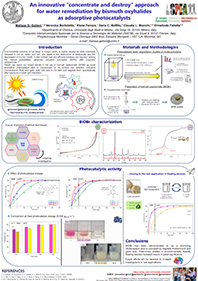
July 2022
The continuous release of toxic chemicals in the environment requires efficient solutions in the view of preserving the Earth even more. Among all the possible strategies to use, those related to advanced oxidation processes result interesting. In this work, an innovative “concentrate and destroy” approach for water remediation has been developed using bismuth oxyhalides (BiOX, X = Br, I) as adsorptive photocatalysts in the abatement of model pollutants (i.e., rhodamine B, RhB, and gallic acid, GA).
Results indicated the superior photoactivity of BiOBr with respect to BiOI. Indeed, BiOBr was able to almost full convert both RhB and GA after 210 min of photocatalytic test under solar light irradiation. The encouraging results obtained open the future possibility to support these materials in floating devices for real applications.

N. Davari, M. Gar Alalm, C. L. Bianchi, E. Falletta, and D. C. Boffito
ECS Montréal Student Symposium - April 2022
The widespread of biorecalcitrant pollutants in the aquatic system has recently encouraged the developing of innovative and inexpensive materials to selectively degrade these pollutants. However, the skepticism about the fate and impacts of novel materials (e.g., nanoscale photocatalysts) has hindered the large-scale applications.
To overcome this issue, we developed an Ag doped TiO2 supported on a floating polyurethane foam (Ag-TiO2-PU) which keeps the photocatalyst inside the reactor and allows the reuse without the need of the tedious collecting step.
The successful doping of Ag in the lattice of TiO2 was confirmed by X-ray diffraction (XRD) and X-ray fluorescence (XRF) analyses.
A remarkable reduction of the bandgap was also observed due to the Ag doping which suggests the activity under wider spectra of solar light. The developed system achieved a complete degradation of methyl orange with an initial concentration of 10 mg/L in 300 min and showed high stability for four cycles of reuse without regeneration or further treatment.

N. Davari, M. Mokhtarifar, C. L. Bianchi, E. Falletta, and D. C. Boffito
Chemical Engineering Research Days - March 2022
In the present study, we fabricated a TiO2-2%Ag photocatalyst supported on a floating Polyurethane foam (TiO2-2%Ag@PU) for the degradation of Methyl Orange dye (MO) in contaminated water under simulated sunlight. X-ray diffraction (XRD) and X-ray fluorescence (XRF) analyses confirmed the successful doping of Ag into TiO2.
The presence of Ag on TiO2-2%Ag@PU photocatalyst resulted in a 10% increase in MO photocatalysis. In addition, the effect of ultrasound on the performance of the floating TiO2-2%Ag@PU photocatalyst was examined.
According to the results, the application of ultrasound in the floating photocatalyst synthesis increased the degradation efficiency of MO by 15%.
We obtained the complete degradation with 10 mg/L MO and 1 g/L TiO2-2%Ag@PU at 300 min. Moreover, the floating photocatalyst was still active and stable after four recycle tests. The results indicated that the floating TiO2-2%Ag@PU can be a promising photocatalyst for the treatment of MO in polluted water.
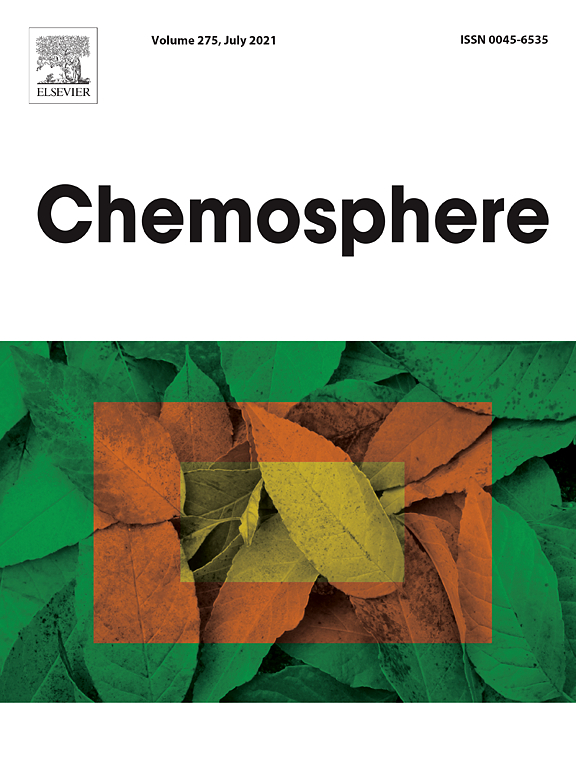
C. L. Bianchi, R. Djellabia, C. Della Pina, E. Falletta
Chemosphere - Volume 286, Part 3, January 2022
https://doi.org/10.1016/j.chemosphere.2021.131941
Recently, the engineering of alternative adsorbents with better functional and sorbing ability towards the purification of wastewaters has received much attention from the scientific community.
Currently polymers, in particular, are regarded as attractive soft materials in the eld of environmental remediation due to their several unique properties. In this regard, the synthesis method is key point to fabricate polymer-based adsorbent with targeted characteristics.
In the present work, four polyaniline (PANIs) samples were synthesized by two alternative chemical approaches, a traditional one and an eco-friendly one, and two different dopants were used, HCl and H2SO4, respectively.
All PANIs were characterized for their thermal, optical, morphological, and structural properties and their capability to remove simultaneously dyes and heavy metals from water have been investigated. It was deduced that the sorption ability is dependent on the as-synthesized PANI using different procedures and dopants. All the PANIs from traditional method showed high levels of pollutants removal (from 89 to 97%).
Even though the materials obtained from the green way are overall less active, H2SO4-doped corresponding polymer showed high sorption capability (75–97%).
Finally, the most performing PANIs were selected for recycling tests exhibiting high sorption ef ciency retention up to four runs without any regeneration treat- ment. Most important, the cycling tests were stopped well before the sample sorption limit could be reached.
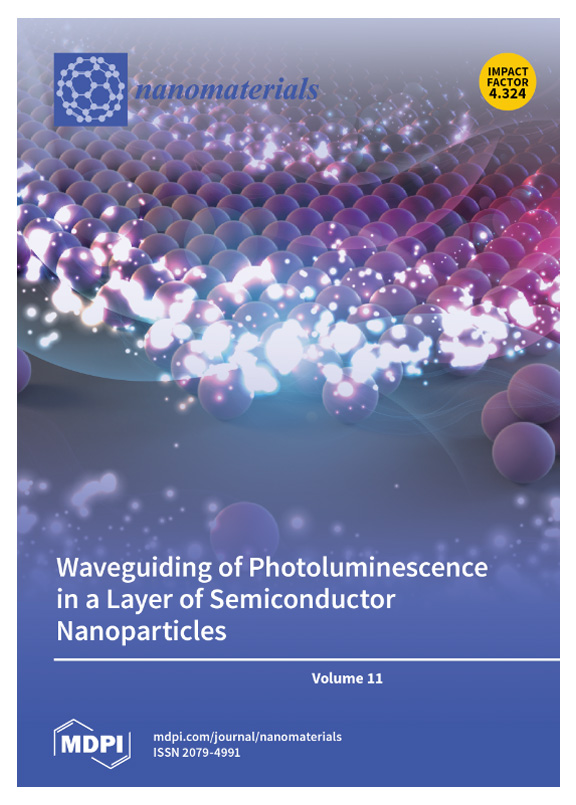
E. Falletta, A. Bruni, M. Sartirana, D. C. Boffito, G. Cerrato, A. Giordana, R. Djellabi, E. S. Khatibi and C. L. Bianchi
Nanomaterials 2021, 11(11), 3071
https://doi.org/10.3390/nano11113071
In the present study, the development of innovative polyurethane-polyaniline/TiO2 modified floating materials applied in the sorption and photodegradation of rhodamine B from water matrix under solar light irradiation is reported.
All the materials were fabricated with inexpensive and easy approaches and were properly characterized. The effect of the kind of polyaniline (PANI) dopant on the materials’ behavior was investigated, as well as the role of the conducting polymer in the pollutant abatement on the basis of its physico-chemical characteristics. Rhodamine B is removed by adsorption and/or photodegradation processes depending on the type of doping agent used for PANI protonation. The best materials were subjected to recycle tests in order to demonstrate their stability under the reaction conditions.
The main transformation products formed during the photodegradation process were identified by ultraperformance liquid chromatography-mass spectrometry (UPLC/MS). The results demonstrated that photoactive floating PANI/TiO2 composites are useful alternatives to common powder photocatalysts for the degradation of cationic dyes.

R. Djellabi, X. Zhao, M. Frias Ordonez, E. Falletta, C. L. Bianchi
Chemosphere - Volume 281, October 2021
https://doi.org/10.1016/j.chemosphere.2021.130839
A massive amount of research has been done over the last three decades to develop photoactive materials which could be suitable for real-world use in water remediation sector.
Water-floating photocatalysts could be one of the best options due to their technological characteristics in terms of efficiency and reasonability including a high oxygenation of the photocatalyst surface, a fully sunlight irradiation, easy recovery and reuse.
In the present study, aerogel water-floating based materials were fabricated using poly(vinyl alcohol) and polyvinylidene fluoride as a polymer platform, and loaded with different semiconductors such as g-C3N4, MoO3, Bi2O3, Fe2O3 or WO3.
The photocatalytic efficiencies of aerogel floating materials and the suspension of above-mentioned semiconductors were compared evaluating the photoreduction of Cr(VI) under visible light (λ > 420 nm).
The results showed that Fe2O3 suspension was the most efficient but the slowest in floating system. On the contrary, g-C3N4 exhibited a good performance in suspension system, and on top of that it was very effective in floating system, wherein it ensures a total reduction of 10 ppm-Cr(VI) to Cr(III) within 20 min.
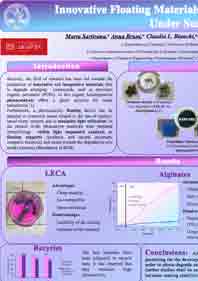
October 2021
Recently, the field of research has been led towards the production of innovative and inexpensive materials able to degrade emerging compounds, such as persistent organic pollutants (POPs). In this regard, heterogeneous photocatalysis offers a green solution for water remediation.
Furthermore, a photocatalytic floating device can be adopted to overcome issues related to the use of catalyst- based slurry systems and to maximize light utilization. In the present work, photoactive materials were prepared immobilizing visible light responsive catalysts on floating supports (synthetic and natural polymers, inorganic materials) and tested towards the degradation of a model molecule (Rhodamine B RHB).
October 2021
Every year, from 300 to 500 millions of tons of solvents, heavy metals, toxic sewage sludges and others industrial waste are released in water.
The most employed approach for waste abatement is based on the use of activated carbon thanks to its high surface area, high porosity and low selectivity. The main disadvantage of this material is the necessity to activate and regenerate it through thermic treatment at high temperature or using solvents, causing additional costs.
In this regard, the necessity to develop innovative materials is crucial. The present study is focused on the “green” synthesis and characterization of porous polyanilines (PANI), characterized by specific features that make them useful for the removal of two classes of wastewater pollutants: organic dyes (methylene blue, MB, and acid green, AG) and heavy metals (Pb+2, Cd+2 and Cr+6).
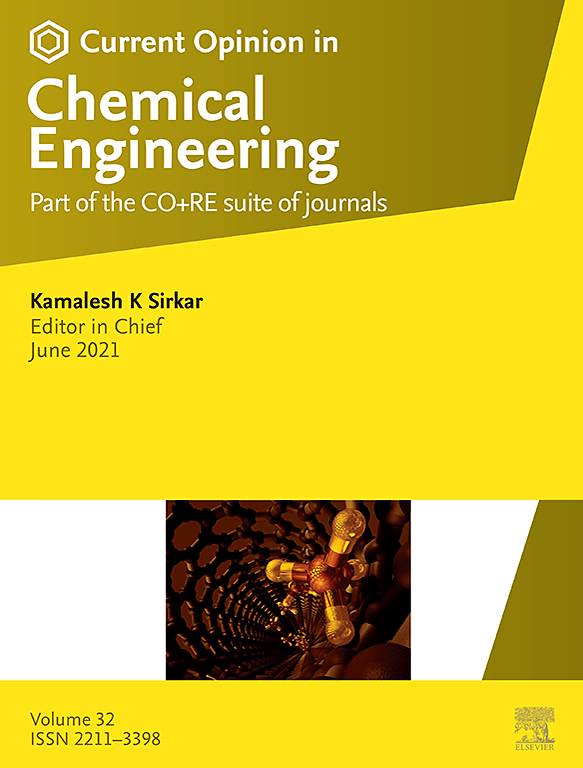
R. Djellabi, R. Giannantonio, E. Falletta and C. L. Bianchi
Current Opinion in Chemical Engineering - Volume 33, September 2021, 100696
https://doi.org/10.1016/j.coche.2021.100696
After a long process of intense fundamental and scientific research, the question of the suitability of photocatalytic technology to address real environmental problems is still alive.
Although photocatalysis has exceptional and unique properties, it still suffers from some technical problems that limit its large-scale transfer.
Furthermore, part of the scientific community focuses on research impossible to apply in industry due to both costs and technical difficulties in large-scale transfer, and testing conditions are often very far from real ones.
In this report, a SWOT analysis of photocatalytic technology is conducted in order to assess whether its main strengths can enable it to seize relevant opportunities for large-scale investment and commercialization of photocatalytic solutions, despite its weaknesses and external threats.
Exploiting and extending all the properties of photocatalysis can transform a plain chemical process in a real and truly competitive technology.
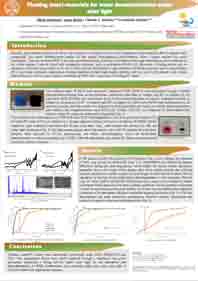
September 2021
Recently, groundwater pollution has driven the necessity to develop innovative and inexpensive smart-materials able to degrade toxic compounds, that lower drinking-water quality. In this regard, heterogeneous photocatalysis offers a green solution for water remediation. Titanium dioxide (TiO2) is the most used photocatalyst, however, to broaden its band-gap extending the photo-response to the visible region, it can be doped with conductive polymers, such as polyaniline (PANI).
Moreover, a floating device can be adopted to overcome issues related to the use of slurry systems and maximize light utilization. Synthetic polymers, such as polyurethane (PU), have been commonly employed as floating materials for their light-weight, stability, and low cost. In the present work, visible light photoactive devices were prepared immobilizing PANI/TiO2 composites on floating PU foams.
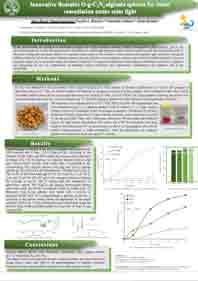
September 2021
In the last decades, the attention to freshwater pollution has further attracted research towards heterogeneous photocatalysis. g-C3N4 has promising features as a metal-free photocatalyst considering its visible-light response, simple synthetic pathway, and cheap production cost.
Moreover, floating devices can be adopted to overcome issues related to its recovery in slurry systems and maximize light utilization. Among the different materials that can be used as floating matrices, natural polymers, such as alginate, occupy a special place for high availability, low cost, and green impact. In the present study, g-C3N4 and O-doped g-C3N4-alginate photocatalysts were properly synthesized and tested to degrade a dye (rhodamine B) and two contaminants of emerging concern (diclofenac and isoproturon), outperforming TiO2-alginates used as the benchmark.

D. Meroni, C. L. Bianchi, D. C. Boffito, G.Cerrato, A. Bruni, M. Sartiranaa, E. Falletta
Ultrasonics Sonochemistry - Volume 75, July 2021, 105615
https://doi.org/10.1016/j.ultsonch.2021.105615
The degradation of diclofenac has been realized for the rst time by a piezo-enhanced sonophotocatalytic approach based on ZnO.
The sonophotocatalytic degradation showed a slight enhancement in the degradation of the parent compound, whereas strong synergistic effects were observed for the mineralization process when suitable ZnO morphologies are used, reaching 70% of complete degradation of 25 ppm diclofenac using 0.1 g/L ZnO in 360 min.
Tests in a complex water matrix show enhanced diclofenac removal, outperforming a TiO2 benchmark photocatalyst.
These promising experimental results promote this process as a good alternative to traditional degradation approaches for remediation of real water matrices.
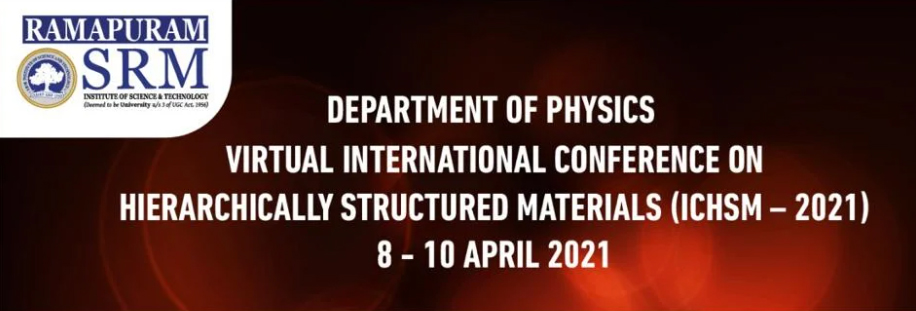
C. L. Bianchi, E. Falletta, A. Bruni, M. Sartirana, M. Gar Alalm, N. Davari, and D. C. Boffito
International Conference on Hierarchically Structured Materials (ICHSM) April 2021
The chemical industry of the forthcoming years will be shaped by a number of emerging global megatrends strictly related to the demand of innovative materials able to solve new needs in different fields. Among them, environmental deterioration and the scarcity of fresh water have become imperative global issues to be solved nowadays. About 2.4 billion people are exposed to diseases caused by inadequate water sanitation. Additionally, a variety of organic and inorganic compounds, which arise either from anthropic activities or naturally, also contaminates drinking water lowering its quality.
In the last three decades, many efforts have been addressed to develop photoactive materials which could be suitable for real-world use in the field of water remediation. In this regard, water-floating photocatalysts could represent good alternatives to traditional materials thanks to their characteristics in terms of efficiency and reasonability including a high oxygenation of the photocatalyst surface, a fully solar irradiation, easy recovery and reuse.
Thanks to its high photocatalytic activity and good stability TiO2 has been proved to be an excellent photocatalyst. However, because of its wide band gap (3.2 eV) its efficiency under solar light is dramatically limited. Hence, much effort has been devoted to improve the utilization of solar light by extending the photoresponse of TiO2 to the visible region.
In this regard, conducting polymers (CPs), such as polyaniline (PANI) and polypyrrole (PPy), represent promising sensitizers to extend the spectral response of TiO2 to visible light. On the basis of our experience in the field of CPs preparation by innovative green approaches and in the advanced oxidation technologies, in the present talk, very recent results will be exposed on the use of CPs-modified TiO2 3D materials floating on the water surface and fully exploiting solar irradiation.
In this very preliminary tests, the degradation of two classes of pollutants has been investigated and the best materials were subjected to recycle tests in order to demonstrate their stability under the reaction conditions.

January 2021
The development of an affordable proof-of-concept device will help to improve the life quality of populations affected by water scarcity.
It will also raise awareness of the importance of sunlight as a sustainable resource for water pollution remediation.